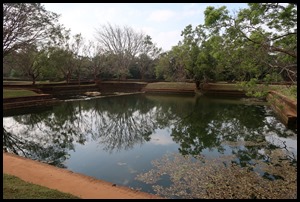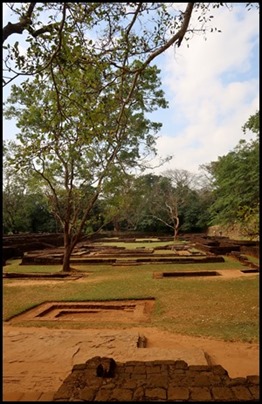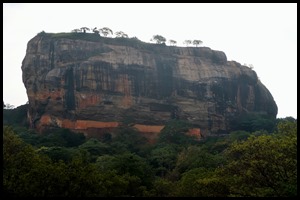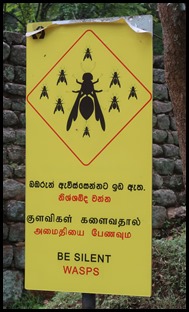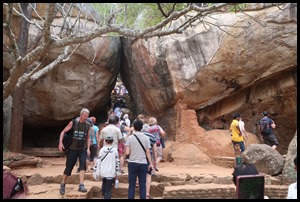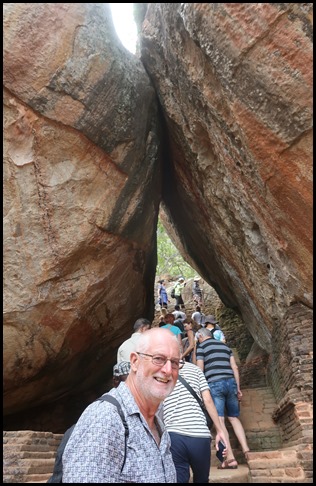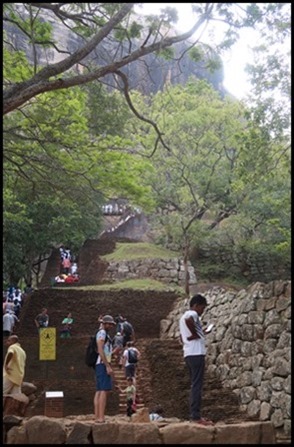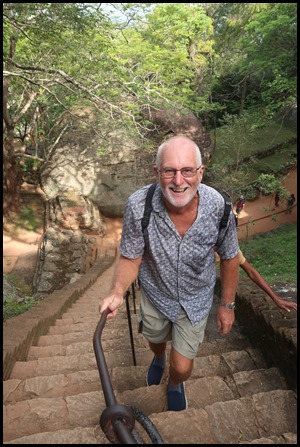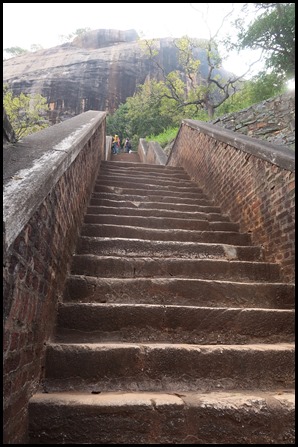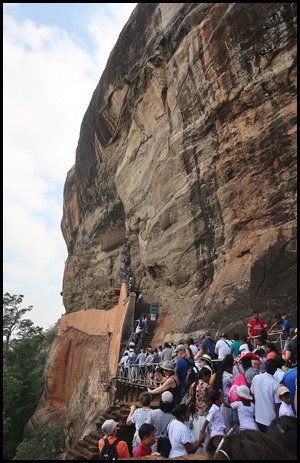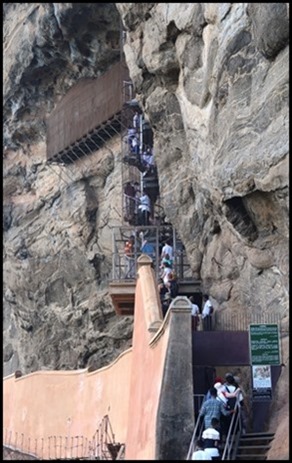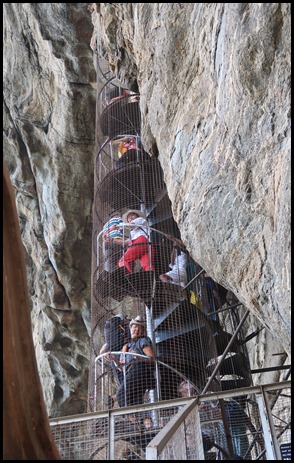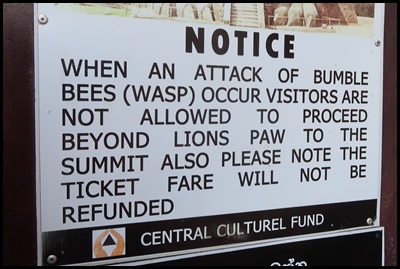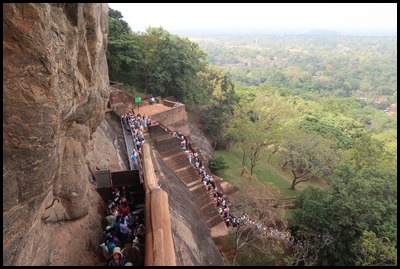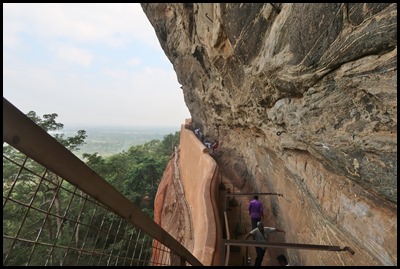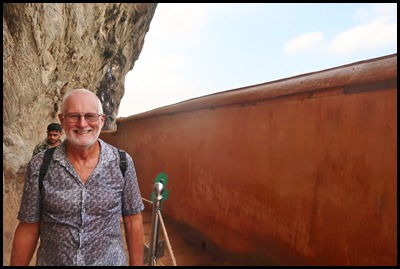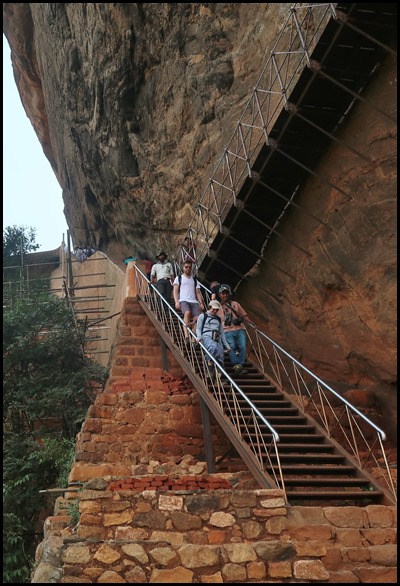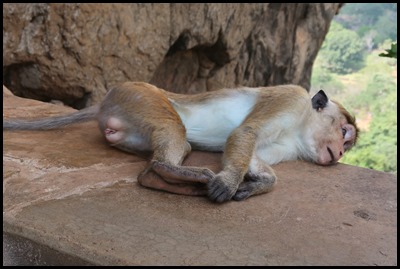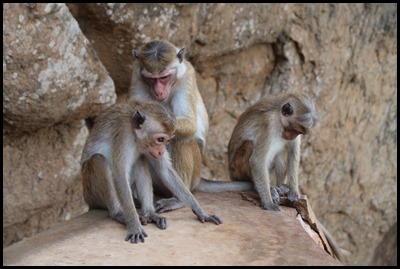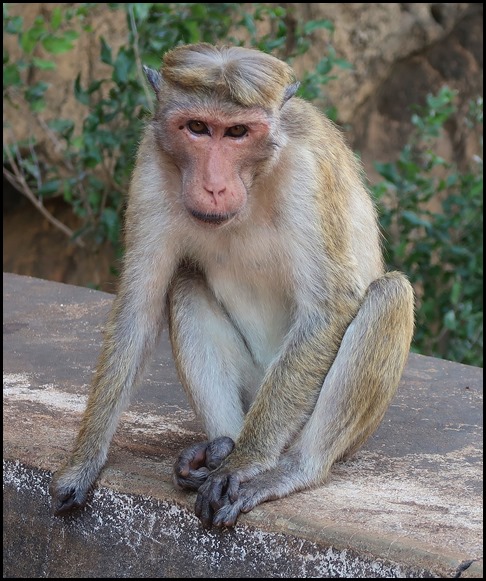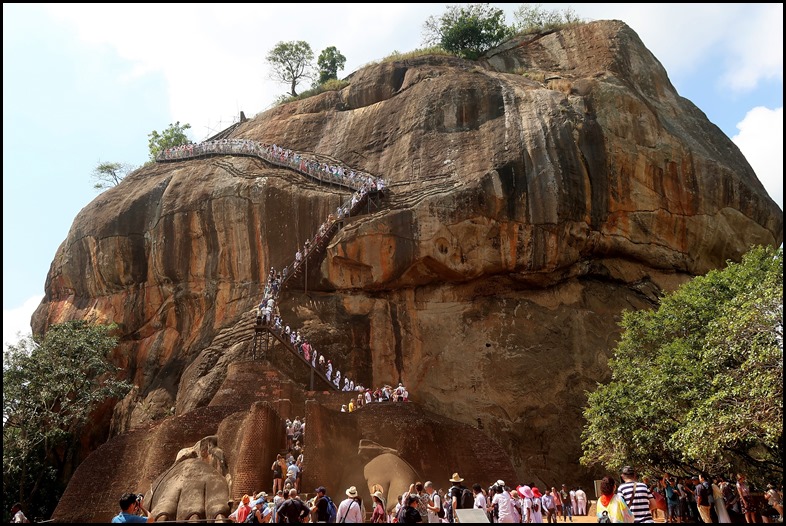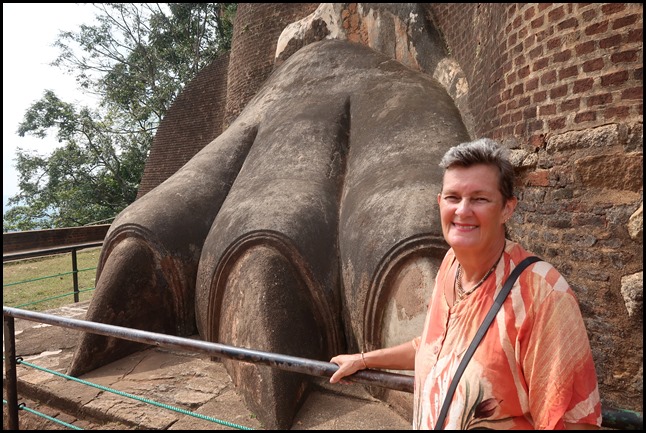Sigiriya Rock 1

|
Sigiriya or Lion Rock – To Lion’s Paw
Terrace
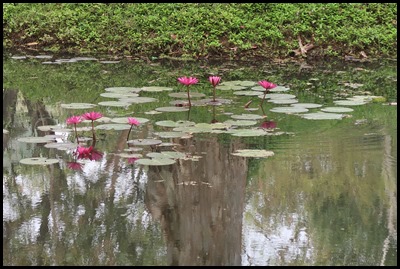 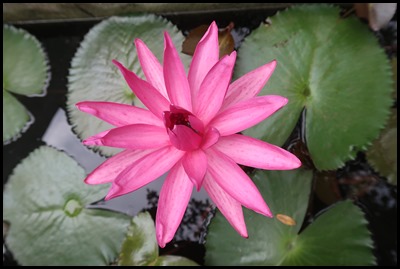 We arrived at Sigiriya and by ten past nine had bought
our tickets – US$30 each and bimbled past a pond with
pretty pink lilies. Referred by locals as the Eighth
Wonder of the World this ancient palace and fortress complex has significant
archaeological importance and attracts thousands of tourists every year. It is
probably the most visited tourist destination of Sri
Lanka.
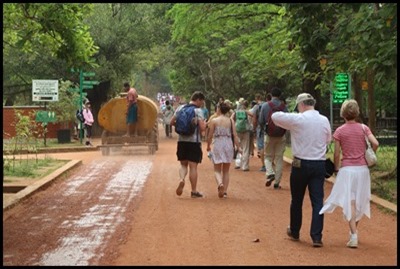 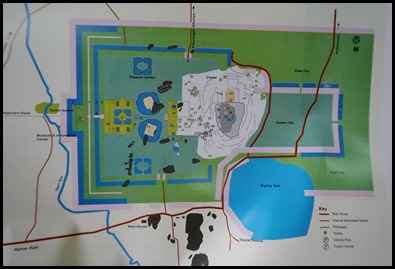 We joined
the throng heading to Lion Rock and were smartly overtaken by a water truck damping down. The map of
the complex.
 Duly noted
sign.
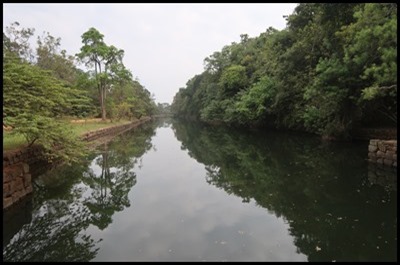 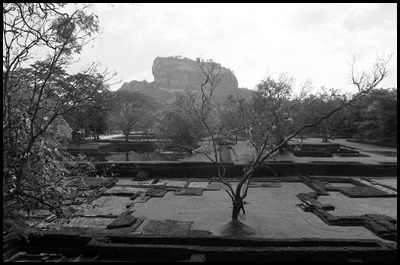 We crossed the moat and took a path saying “View”. Ooooo our first proper look at Sigiriya or Lion Rock. 1200 steps will take us to the top to see the ruined palace located in the heart of the island between the towns of Dambulla and Habarane on this massive rocky plateau 370 meters above the sea level. Sigiriya rock plateau, formed from magma of an extinct volcano, is 200 meters higher than the surrounding jungles. Its view astonishes the visitors with the unique harmony between the nature and human imagination.
The gardens of Sigiriya are among the oldest landscaped gardens in the world. Sigiriya has water gardens, cave and boulder gardens, and also terraced gardens. They are located in the western part of the rock and have a complex hydraulic system, which consists of canals, locks, lakes, dams, bridges, fountains, as well as surface and underground water pumps. In the rainy season, all channels are filled with water, which begins to circulate through the whole area of Sigiriya. Fountains of Sigiriya built in the 5th century, perhaps, are the oldest in the world. The palace and fortress complex is recognised as one of the finest examples of ancient urban planning. Considering the uniqueness of Sigiriya UNESCO declared it a World Heritage site in 1982. Sigiriya is an unmatched combination of urban planning, water engineering, horticulture and arts. (We would take steps to the long paler brown (Mirror Wall), take a spiral staircase to see some frescoes and then steps to the far left of the rock up to Lion’s Paw Terrace. From there to the top).
We passed caves, the surrounding territories of Sigiriya have been inhibited for several thousands of years. A very different sign for us, try telling the coach-load of excited Koreans to be silent........ on we went toward Boulder Alley.
Bear before heading under the boulders and looking down. I was determined not to take pictures of every information board but......This is on the ancient pathway and is a fine example of adopting the features of the natural landscape in Sigiriya planning. On either side of the boulder arch are two caves prepared as dwellings for the Sangha during the first monastic phase before Kasyapa. In the one on the left is an inscription in early-brahmi script. It says: ‘ Parumaka Kadiya putasha...’ which means (the cave of) chieftain Kadiya’s son. What is seen inside the cave is a part of a limestone seat made for the use of meditating monks.
Our first serious sets of steps. Half way up the middle picture Bear and I were scooped up by “we work here”. Held in an arresting fashion we were literally pulled up a few steps before I politely declined and told Bear’s that his dodgy knees required him to go at his own pace. “But we only want US$20 each”. Is it time to learn a local phrase or two wethinks........
The next bit was assembling ourselves into single file, there are simply some nations that do not understand this concept, women should not carry handbags of a sufficient capacity to carry a small combine harvester and men should be hurt when they spin around in a crowded place whilst wearing a sharp-edged backsack.... Up a spiral staircase along a fresco gallery – no photography allowed and down a matching spiral staircase.
We would get to see many examples of the frescoes when we visited the National Museum in Colombo a couple of days later. All paintings feature scantily clad ladies. The western wall of Sigiriya was almost entirely covered by frescoes, created during the reign of Kasyapa. Eighteen frescoes have survived to this day. The frescoes are depicting nude females and are considered to be either the portraits of Kasyapa’s wives and concubines or priestess performing religious rituals. Despite the unknown identity of the females depicted in the frescoes, these unique ancient paintings are celebrating female beauty and have incredible historical significance. The view as we went higher.
No refund seems a bit harsh and nowhere in the literature does anyone mention bringing an Epipen........as the chances of getting to the first aid hut on Lion Terrace on a day when throngs of people are focussed, single-minded and forced through the one-way system......Mmmmm....... The queue behind us now snaked a long way through the trees toward the drop-off car park.
We came down the down spiral staircase and looked along the Mirror Wall. Bear shows the height of the wall and looks happy about that..... A striking feature and in the old days it was polished so thoroughly that the king could see his reflection in it. This wall is of architectural and also of literary importance because of its graffiti. Visitors to Sigiriya from the 7th to the 19th centuries AD have left their comments here. The body of literature known as the ‘graffiti’ belongs to the 7th – 13th centuries AD. The graffiti expresses feelings of enchantment with the paintings and the surrounding environment are not only of literary and philological (sic) importance but they also provide contemporary social information. Most of the scribble after the 13th century is mere reportage lacking poetic intensity and feeling. Prof. Senerat Paranavitana has deciphered 685 of the graffiti and has published them in a two volume publication titled ‘Sigiri Graffiti’. ANd subsequently several other scholars have also deciphered other graffiti available on the mirror wall. These inscriptions prove that Sigiriya was a tourist destination more than a thousand years ago. Today, painting on the wall is strictly prohibited.
At the end of the mirror wall we looked down on a lovely terrace currently under renovation. Then it was up the next set of steps.
At the top of the steps was a chilled monkey. Even those not dozing happily minded their own business. A very different experience to the savage horrors we met in Myanmar.
Loved this ones toupee so much we called him Bruce.
Lion Rock. Standing here in the ‘old days’ we would have looked up and seen a massive lion, just the Lion’s Paws survive today as the upper parts of the body were destroyed. It was this lion that gave the name - Sigiriya. The term Sigiriya originates from the word Sihagri, i.e. Lion Rock. The Lion’s Paw Terrace is another noteworthy feature in the layout of Sigiriya. It is a plateau facing north at the base of Lion-Staircase, the gateway to the main palace on the summit. The colossal paws and surviving mass of brick masonry at the base of the rock provide, even today, a clear picture of the form and scale of this gatehouse. The lion seems to have been in a crouching position, represented by its front paws, head and shoulders projecting from the rock. Several ruins of other buildings could also be seen here among which are moonstones and guardstones of various sizes made from limestone. Recent archaeological explorations and excavations have revealed evidence of a flight of steps leading from the northern gate to this terrace.
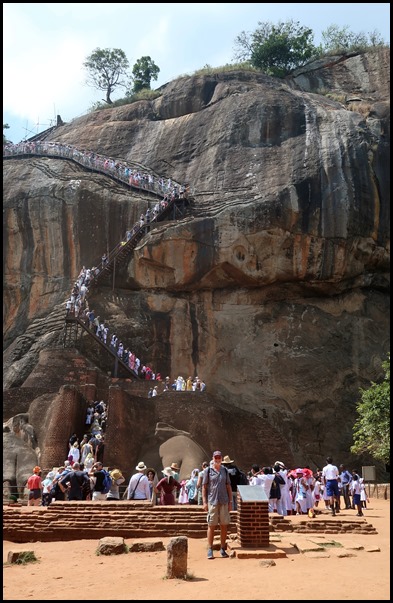 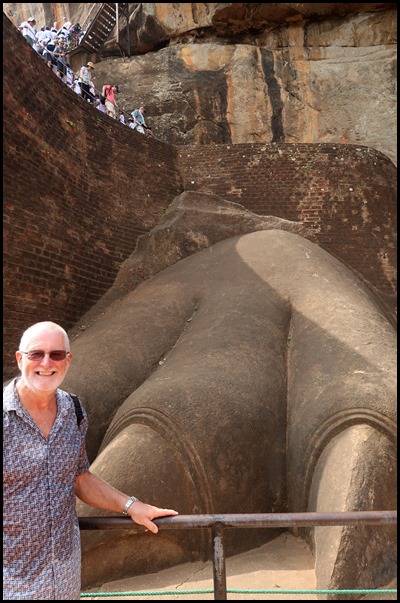
Thought - we had made it to Lion’s Paw Terrace, now for the steep bit......
ALL IN ALL WHAT A SPECIAL PLACE TO VISIT QUITE A CLIMB AND AMAZING CROWDS |
